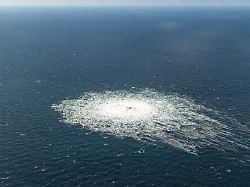USA, Russia, Ukraine in sight
One year later: Who is behind the Nord Stream sabotage?
September 26, 2023, 11:47 a.m
A year ago – amid geopolitical tensions over Russia’s invasion of Ukraine and the gas crisis in Europe – explosions tore several holes in the Nord Stream 1 and 2 natural gas pipelines. Since then, investigators have been puzzling over who was responsible. Here are the most important questions and answers about the case.
What happened?
On September 26, several massive gas leaks were detected on parts of pipelines in international waters off the Danish island of Bornholm and the southern coast of Sweden. Initial investigations revealed that explosions underwater caused severe, possibly irreparable damage to the pipes. Natural gas continued to leak for days until the pipes emptied.
At this point, Russia had already stopped gas deliveries through the Nord Stream 1 pipes due to Western sanctions. The new Nord Stream 2 pipeline had been completed for months, but a few days before Russia’s attack on Ukraine at the end of February, the federal government put the project on hold. The new pipelines – construction costs: around ten billion euros – were never put into operation.
Nord Stream 2 in particular had previously caused controversy for years: Germany, together with Russia, pushed ahead with construction despite the annexation of the Crimean Peninsula in 2014, which violated international law – against strong protests from the USA and Eastern and Central European states such as Poland and Ukraine.
Silent investigators
Investigations into the pipeline sabotage have been launched in Germany, Sweden and Denmark, none of which have yet been completed. The responsible authorities are holding back from making public statements, which observers attribute to the potential diplomatic consequences of the incident.
“The main hypothesis is that a state is behind this,” Swedish prosecutor Mats Ljungqvist said in April. Last week he announced that the Swedish investigation was nearing completion.
German investigators in January searched a sailing yacht that may have been used to transport the explosives used in the sabotage. The Federal Prosecutor’s Office declined to comment on media reports that a team of five men and one woman are said to have chartered the yacht “Andromeda” in the Rostock harbor: the identity and motives of the perpetrators are the subject of ongoing investigations.
Numerous media reports
A series of investigative research led to widely noticed reports – none of which have yet been officially confirmed. According to the Dutch broadcaster NOS, “Zeit” and ARD, the Dutch military intelligence service had warned the CIA three months before the explosions about Ukrainian plans to blow up the pipeline. A report from the Washington Post also went in this direction.
Ukrainian President Volodymyr Zelensky repeatedly rejected the accusation that his country was behind the sabotage. Investigative reporters from the New York Times reported that, according to the US government’s findings, a “pro-Ukrainian group” was behind the detonations. However, there is no evidence of the Ukrainian president’s knowledge or involvement.
The “Spiegel” and the ZDF for their part followed the trail of the “Andromeda”. According to their research, a fake passport used to rent the sailboat leads to a Ukrainian soldier. The charter fee was also paid by a company registered in Poland that had connections to a woman in Kiev.
False flag theory: “Andromeda” trail could also point to Moscow
However, research by RTL and ntv shows that one of the women named in the company’s documents is Russian. After the annexation of the Crimean peninsula by Russia in 2014, she helped to hold elections for the occupiers. According to the Polish commercial register, the woman owns the company that, according to German investigators, is said to have rented the “Andromeda”.
Experts also do not rule out a “false flag” operation by Russia. Clues could therefore have been deliberately planted to shift the blame to Ukraine. Andreas Umland, an analyst at the Stockholm Center for Eastern European Studies, believes Moscow is the “most likely” culprit because any suspected Kiev involvement in an attack on European energy infrastructure could jeopardize Western support for Ukraine.
At the same time, the destroyed pipelines could help the Russian gas company Gazprom to avoid compensation claims for undelivered gas. Moscow may have tried to “kill two birds with one stone,” says Umland. The Kremlin firmly denies responsibility for the sabotage.
Danish media also reported that a Russian naval vessel specializing in submarine operations was photographed nearby days before the explosions.
Hersh sees US divers at work
The well-known US investigative reporter Seymour Hersh caused a stir with a report according to which US navy divers were said to have attached explosive devices to the gas pipelines as early as June 2022. These were detonated remotely in September. The US government has firmly rejected this. Independent fact-checkers point out inconsistencies in the Hersh report.
